Yadong Niu
MiDashengLM: Efficient Audio Understanding with General Audio Captions
Aug 06, 2025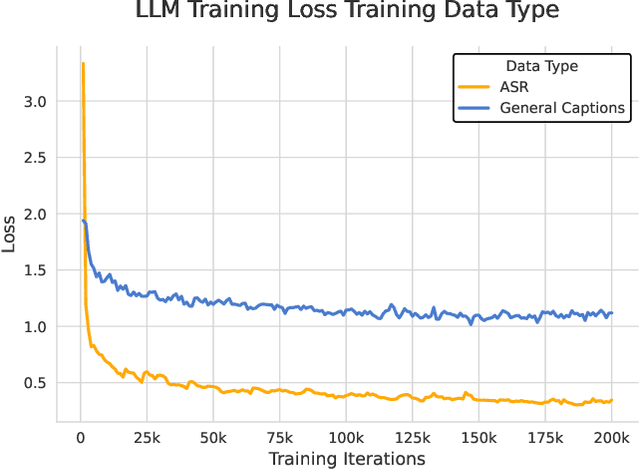
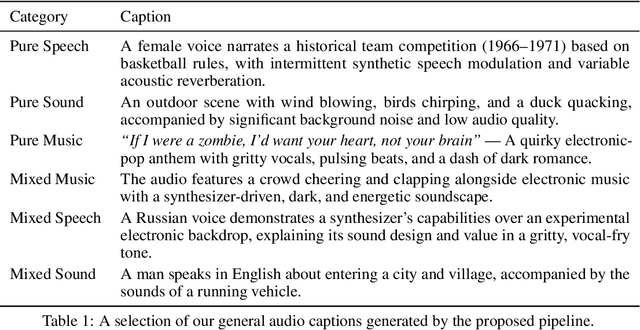
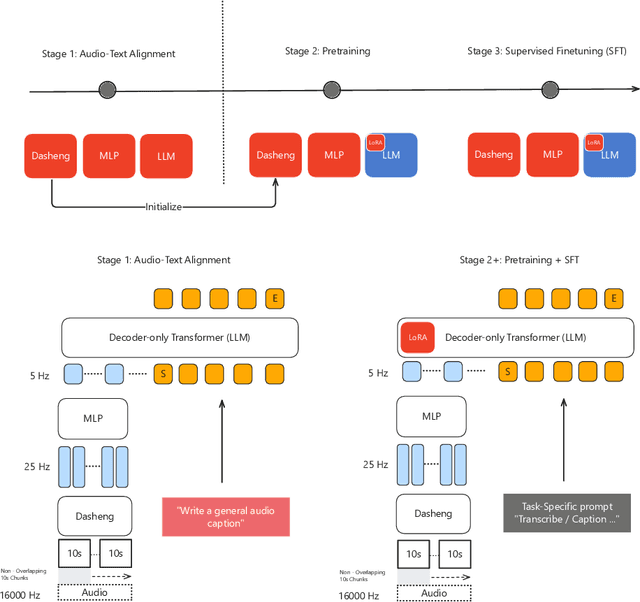
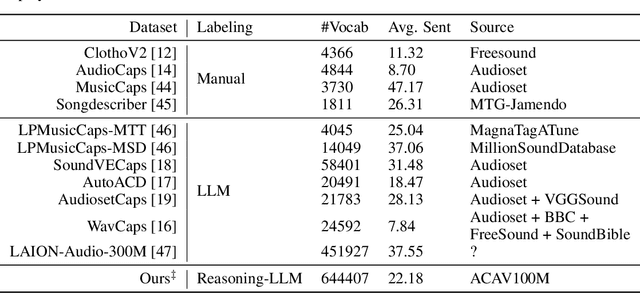
Abstract:Current approaches for large audio language models (LALMs) often rely on closed data sources or proprietary models, limiting their generalization and accessibility. This paper introduces MiDashengLM, a novel open audio-language model designed for efficient and comprehensive audio understanding through the use of general audio captions using our novel ACAVCaps training dataset. MiDashengLM exclusively relies on publicly available pretraining and supervised fine-tuning (SFT) datasets, ensuring full transparency and reproducibility. At its core, MiDashengLM integrates Dasheng, an open-source audio encoder, specifically engineered to process diverse auditory information effectively. Unlike previous works primarily focused on Automatic Speech Recognition (ASR) based audio-text alignment, our strategy centers on general audio captions, fusing speech, sound and music information into one textual representation, enabling a holistic textual representation of complex audio scenes. Lastly, MiDashengLM provides an up to 4x speedup in terms of time-to-first-token (TTFT) and up to 20x higher throughput than comparable models. Checkpoints are available online at https://huggingface.co/mispeech/midashenglm-7b and https://github.com/xiaomi-research/dasheng-lm.
Efficient Speech Enhancement via Embeddings from Pre-trained Generative Audioencoders
Jun 13, 2025Abstract:Recent research has delved into speech enhancement (SE) approaches that leverage audio embeddings from pre-trained models, diverging from time-frequency masking or signal prediction techniques. This paper introduces an efficient and extensible SE method. Our approach involves initially extracting audio embeddings from noisy speech using a pre-trained audioencoder, which are then denoised by a compact encoder network. Subsequently, a vocoder synthesizes the clean speech from denoised embeddings. An ablation study substantiates the parameter efficiency of the denoise encoder with a pre-trained audioencoder and vocoder. Experimental results on both speech enhancement and speaker fidelity demonstrate that our generative audioencoder-based SE system outperforms models utilizing discriminative audioencoders. Furthermore, subjective listening tests validate that our proposed system surpasses an existing state-of-the-art SE model in terms of perceptual quality.
GLAP: General contrastive audio-text pretraining across domains and languages
Jun 12, 2025Abstract:Contrastive Language Audio Pretraining (CLAP) is a widely-used method to bridge the gap between audio and text domains. Current CLAP methods enable sound and music retrieval in English, ignoring multilingual spoken content. To address this, we introduce general language audio pretraining (GLAP), which expands CLAP with multilingual and multi-domain abilities. GLAP demonstrates its versatility by achieving competitive performance on standard audio-text retrieval benchmarks like Clotho and AudioCaps, while significantly surpassing existing methods in speech retrieval and classification tasks. Additionally, GLAP achieves strong results on widely used sound-event zero-shot benchmarks, while simultaneously outperforming previous methods on speech content benchmarks. Further keyword spotting evaluations across 50 languages emphasize GLAP's advanced multilingual capabilities. Finally, multilingual sound and music understanding is evaluated across four languages. Checkpoints and Source: https://github.com/xiaomi-research/dasheng-glap.
X-ARES: A Comprehensive Framework for Assessing Audio Encoder Performance
May 22, 2025Abstract:We introduces X-ARES (eXtensive Audio Representation and Evaluation Suite), a novel open-source benchmark designed to systematically assess audio encoder performance across diverse domains. By encompassing tasks spanning speech, environmental sounds, and music, X-ARES provides two evaluation approaches for evaluating audio representations: linear fine-tuning and unparameterized evaluation. The framework includes 22 distinct tasks that cover essential aspects of audio processing, from speech recognition and emotion detection to sound event classification and music genre identification. Our extensive evaluation of state-of-the-art audio encoders reveals significant performance variations across different tasks and domains, highlighting the complexity of general audio representation learning.
Reinforcement Learning Outperforms Supervised Fine-Tuning: A Case Study on Audio Question Answering
Mar 17, 2025
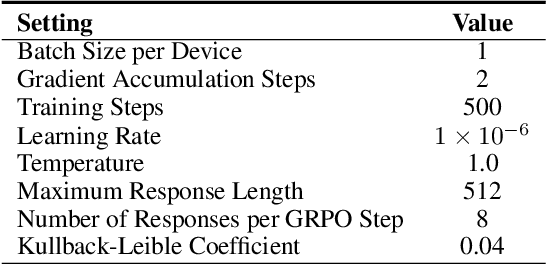

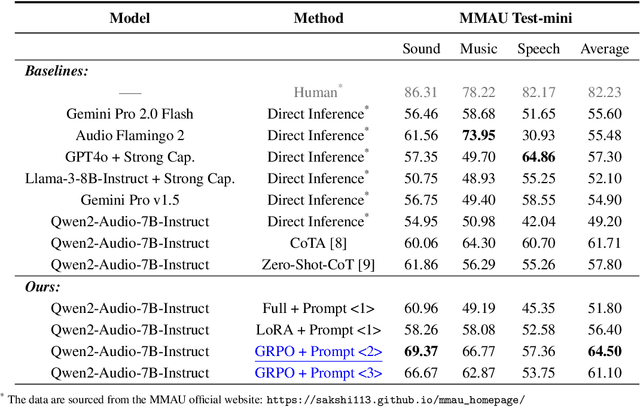
Abstract:Recently, reinforcement learning (RL) has been shown to greatly enhance the reasoning capabilities of large language models (LLMs), and RL-based approaches have been progressively applied to visual multimodal tasks. However, the audio modality has largely been overlooked in these developments. Thus, we conduct a series of RL explorations in audio understanding and reasoning, specifically focusing on the audio question answering (AQA) task. We leverage the group relative policy optimization (GRPO) algorithm to Qwen2-Audio-7B-Instruct, and our experiments demonstrated state-of-the-art performance on the MMAU Test-mini benchmark, achieving an accuracy rate of 64.5%. The main findings in this technical report are as follows: 1) The GRPO algorithm can be effectively applied to large audio language models (LALMs), even when the model has only 8.2B parameters; 2) With only 38k post-training samples, RL significantly outperforms supervised fine-tuning (SFT), indicating that RL-based approaches can be effective without large datasets; 3) The explicit reasoning process has not shown significant benefits for AQA tasks, and how to efficiently utilize deep thinking remains an open question for further research; 4) LALMs still lag far behind humans auditory-language reasoning, suggesting that the RL-based approaches warrant further exploration. Our project is available at https://github.com/xiaomi-research/r1-aqa and https://huggingface.co/mispeech/r1-aqa.
The ICME 2025 Audio Encoder Capability Challenge
Jan 25, 2025Abstract:This challenge aims to evaluate the capabilities of audio encoders, especially in the context of multi-task learning and real-world applications. Participants are invited to submit pre-trained audio encoders that map raw waveforms to continuous embeddings. These encoders will be tested across diverse tasks including speech, environmental sounds, and music, with a focus on real-world usability. The challenge features two tracks: Track A for parameterized evaluation, and Track B for parameter-free evaluation. This challenge provides a platform for evaluating and advancing the state-of-the-art in audio encoder design.
Beware of Overestimated Decoding Performance Arising from Temporal Autocorrelations in Electroencephalogram Signals
May 27, 2024



Abstract:Researchers have reported high decoding accuracy (>95%) using non-invasive Electroencephalogram (EEG) signals for brain-computer interface (BCI) decoding tasks like image decoding, emotion recognition, auditory spatial attention detection, etc. Since these EEG data were usually collected with well-designed paradigms in labs, the reliability and robustness of the corresponding decoding methods were doubted by some researchers, and they argued that such decoding accuracy was overestimated due to the inherent temporal autocorrelation of EEG signals. However, the coupling between the stimulus-driven neural responses and the EEG temporal autocorrelations makes it difficult to confirm whether this overestimation exists in truth. Furthermore, the underlying pitfalls behind overestimated decoding accuracy have not been fully explained due to a lack of appropriate formulation. In this work, we formulate the pitfall in various EEG decoding tasks in a unified framework. EEG data were recorded from watermelons to remove stimulus-driven neural responses. Labels were assigned to continuous EEG according to the experimental design for EEG recording of several typical datasets, and then the decoding methods were conducted. The results showed the label can be successfully decoded as long as continuous EEG data with the same label were split into training and test sets. Further analysis indicated that high accuracy of various BCI decoding tasks could be achieved by associating labels with EEG intrinsic temporal autocorrelation features. These results underscore the importance of choosing the right experimental designs and data splits in BCI decoding tasks to prevent inflated accuracies due to EEG temporal autocorrelation.
A breakthrough in Speech emotion recognition using Deep Retinal Convolution Neural Networks
Jul 12, 2017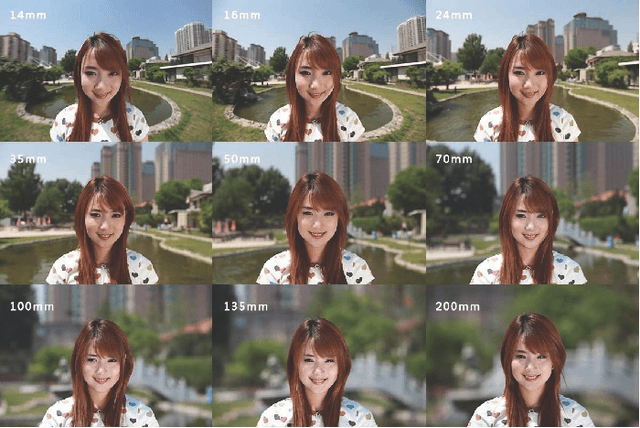
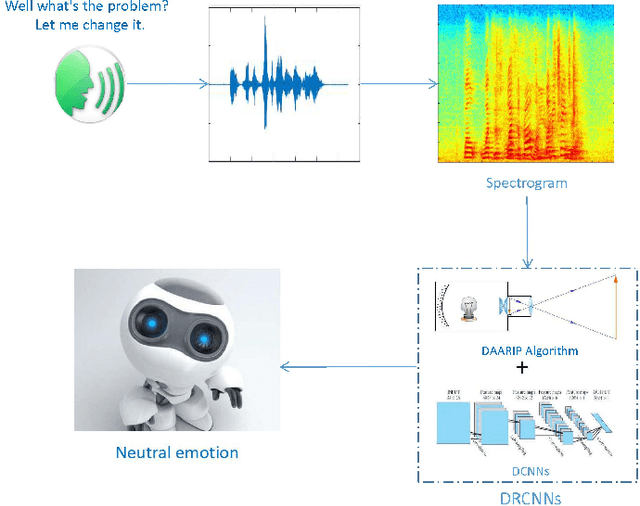


Abstract:Speech emotion recognition (SER) is to study the formation and change of speaker's emotional state from the speech signal perspective, so as to make the interaction between human and computer more intelligent. SER is a challenging task that has encountered the problem of less training data and low prediction accuracy. Here we propose a data augmentation algorithm based on the imaging principle of the retina and convex lens, to acquire the different sizes of spectrogram and increase the amount of training data by changing the distance between the spectrogram and the convex lens. Meanwhile, with the help of deep learning to get the high-level features, we propose the Deep Retinal Convolution Neural Networks (DRCNNs) for SER and achieve the average accuracy over 99%. The experimental results indicate that DRCNNs outperforms the previous studies in terms of both the number of emotions and the accuracy of recognition. Predictably, our results will dramatically improve human-computer interaction.
 Add to Chrome
Add to Chrome Add to Firefox
Add to Firefox Add to Edge
Add to Edge